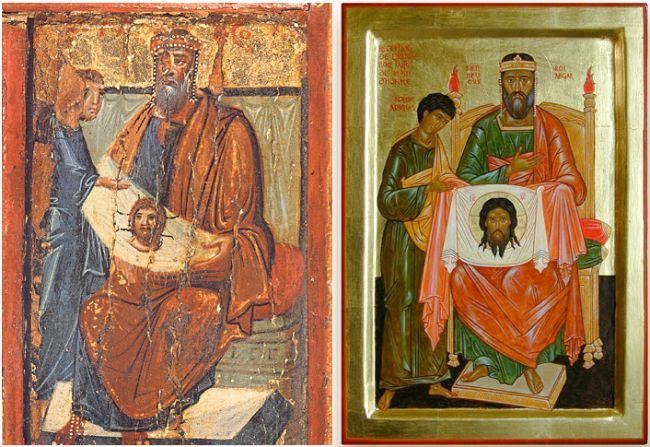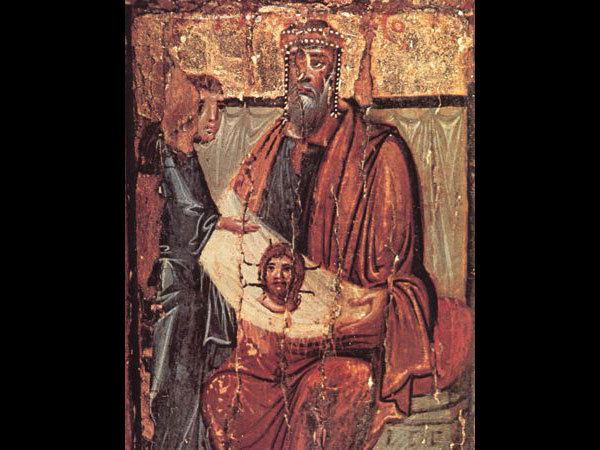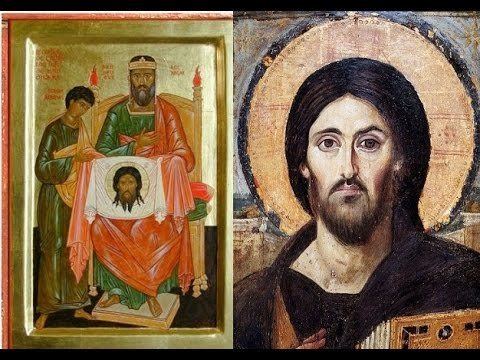Name Abgar V | ||
 | ||
Abgar V
Abgar V the Black or Abgarus V of Edessa (Syriac: ܐܒܓܪ ܚܡܝܫܝܐ ܐܘܟܡܐ, ʾAḇgar Ḥəmišāyā ʾUkkāmā, Armenian: Աբգար Ե Եդեսացի, Abgar Hingerord Yedesatsi, Greek: Ἄβγαρος Abgaros) (BC 4 – AD 7 and AD 13–c. 40) was a historical ruler of the kingdom of Osroene, holding his capital at Edessa.
Contents
- Abgar V
- Life
- The Letter of King Abgar to Jesus
- Liturgical use of the letter of Abgar
- Christian legacy
- Critical scholarship
- References

Life

Movses Khorenatsi says that the chief wife of King Abgar V was Queen Helena of Adiabene, the wife of King Monobaz I of Adiabene, and thus the kingdoms of Edessa and Adiabene were linked in some manner. Professor Robert Eisenman suggests that Queen Helena was the sister-wife of King Abgar V who was given the lands of Adiabene by her brother-husband, the king. Professor Eisenman derived this association from Moses of Chorene mentioning the same famine relief to Judaea as does Flavius Josephus:

The chief of King Abgar’s wives, who was named Helena ... Helena went away to Jerusalem in the time of Claudius, during the famine which Agabus had predicted. Spending all her treasures she bought an immense amount of grain in Egypt, which she distributed to the poor, to which Josephus bears witness. Her famous mausoleum stands before the gate at Jerusalem to this very day.:

Professor Eisenman goes on to equate King Abgarus V with the Agabus in Acts of the Apostles (Acts 11:27-30), because Agabus was identified with the same famine relief as Queen Helena. By necessity Eisenman then equates the biblical Antioch Orontes with Antioch Edessa, indicating that Paul the Apostle and Barnabas went to Edessa.
The Letter of King Abgar to Jesus
Abgar V is claimed to be one of the first Christian kings in history, having been converted to the faith by Thaddeus of Edessa, one of the seventy disciples.
The church historian Eusebius records that the Edessan archives contained a copy of a correspondence exchanged between Abgar of Edessa and Jesus. The correspondence consisted of Abgar's letter and the answer dictated by Jesus. On August 15, 944, the Church of St. Mary of Blachernae in Constantinople received the letter and the Mandylion. Both relics were then moved to the Church of the Virgin of the Pharos.
The account of this enjoyed great popularity in the East, and also in the West, during the Middle Ages: Jesus' letter was copied on parchment, inscribed in marble and metal, and used as a talisman or an amulet. Of this correspondence, there survive not only a Syriac text, but an Armenian translation as well, two independent Greek versions, shorter than the Syriac, and several inscriptions on stone.
A curious growth has arisen from this event, with scholars disputing whether Abgar suffered from gout or from leprosy, whether the correspondence was on parchment or papyrus, and so forth.
The text of the letter was:
Abgar, ruler of Edessa, to Jesus the good physician who has appeared in the country of Jerusalem, greeting. I have heard the reports of you and of your cures as performed by you without medicines or herbs. For it is said that you make the blind to see and the lame to walk, that you cleanse lepers and cast out impure spirits and demons, and that you heal those afflicted with lingering disease, and raise the dead. And having heard all these things concerning you, I have concluded that one of two things must be true: either you are God, and having come down from heaven you do these things, or else you, who does these things, are the son of God. I have therefore written to you to ask you if you would take the trouble to come to me and heal all the ill which I suffer. For I have heard that the Jews are murmuring against you and are plotting to injure you. But I have a very small yet noble city which is great enough for us both.
Jesus gave the messenger the reply to return to Abgar:
Blessed are you who hast believed in me without having seen me. For it is written concerning me, that they who have seen me will not believe in me, and that they who have not seen me will believe and be saved. But in regard to what you have written me, that I should come to you, it is necessary for me to fulfill all things here for which I have been sent, and after I have fulfilled them thus to be taken up again to him that sent me. But after I have been taken up I will send to you one of my disciples, that he may heal your disease and give life to you and yours.
Egeria wrote of the letter in her account of her pilgrimage in Edessa. She read the letter during her stay, and remarked that the copy in Edessa was fuller than the copies in her home (which was likely France).
Liturgical use of the letter of Abgar
In addition to the importance it attained in the apocryphal cycle, the correspondence of King Abgar also gained a place in liturgy for some time. The Syriac liturgies commemorate the correspondence of Abgar during Lent. The Celtic liturgy appears to have attached importance to it; the Liber Hymnorum, a manuscript preserved at Trinity College, Dublin (E. 4, 2), gives two collects on the lines of the letter to Abgar. It is even possible that this letter, followed by various prayers, may have formed a minor liturgical office in some Catholic churches.
Christian legacy
This event has played an important part in the self-definition of several Eastern churches. Abgar is counted as saint, with feasts on May 11 and October 28 in the Eastern Orthodox Church, August 1 in the Syrian Church, and daily in the Mass of the Armenian Apostolic Church. The Armenian Apostolic Church in Scottsdale, Arizona, is named after Saint Abgar (also spelled as Apkar).
On August 24, 2009, the board of the Central Bank of Armenia adopted a decision on introducing a new banknote with a nominal value of AMD 100,000. The new banknote depicts King Abgar V, described as King of Armenian Mesopotamia. The front of the banknote depicts Abgar pointing at the royal flag bearing an image of the Mandylion. The reverse of the banknote depicts disciple Thaddeus of Edessa handing the canvas to King Abgar V and his consequent miraculous healing.
Critical scholarship
A number of contemporary scholars have suggested origins of the tradition of Abgar's conversion apart from historical record. S. K. Ross suggests the story of Abgar is in the genre of a genealogical myth which traces the origin of a community back to a mythical or divine ancestor. F. C. Burkitt argues that the conversion of Edessa at the time of Abgar VIII was retrojected upon the Apostolic age. William Adler suggests the origin of the story of the conversion of Abgar V was an invention of an antiquarian researcher employed by Abgar VIII, who had recently converted to Christianity, in an effort to securely root Christianity in the history of the city. Walter Bauer, on the other hand, argued the legend was written without sources to reinforce group cohesiveness, orthodoxy, and apostolic succession against heretical schismatics.
Significant advances in scholarship on the topic have been made by Desreumaux’s translation with commentary, M. Illert's collection of textual witnesses to the legend, and detailed studies of the ideology of the sources by Brock, Griffith, and Mirkovic. The majority of scholars now claim the goal of the authors and editors of texts regarding the conversion of Abgar were not so much concerned with historical reconstruction of the Christianisation of Edessa as the relationships between church and state power, based on the political and ecclesiological ideas of Ephraem the Syrian. However, the origins of the story are far still from certain, although the stories as recorded seem to have been shaped by the controversies of the third century CE, especially as a response to Bardaisan.
